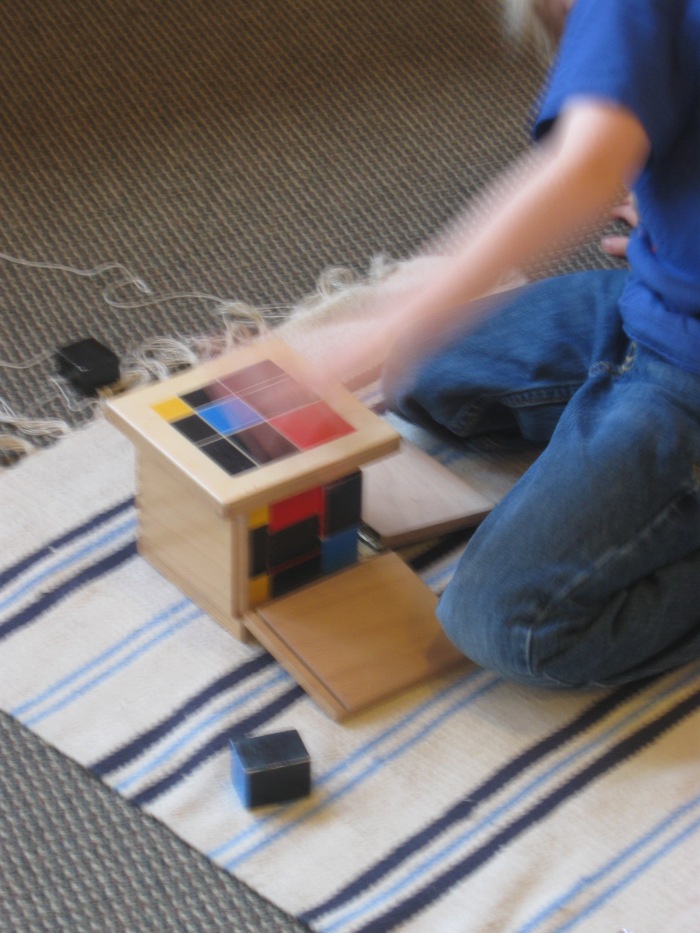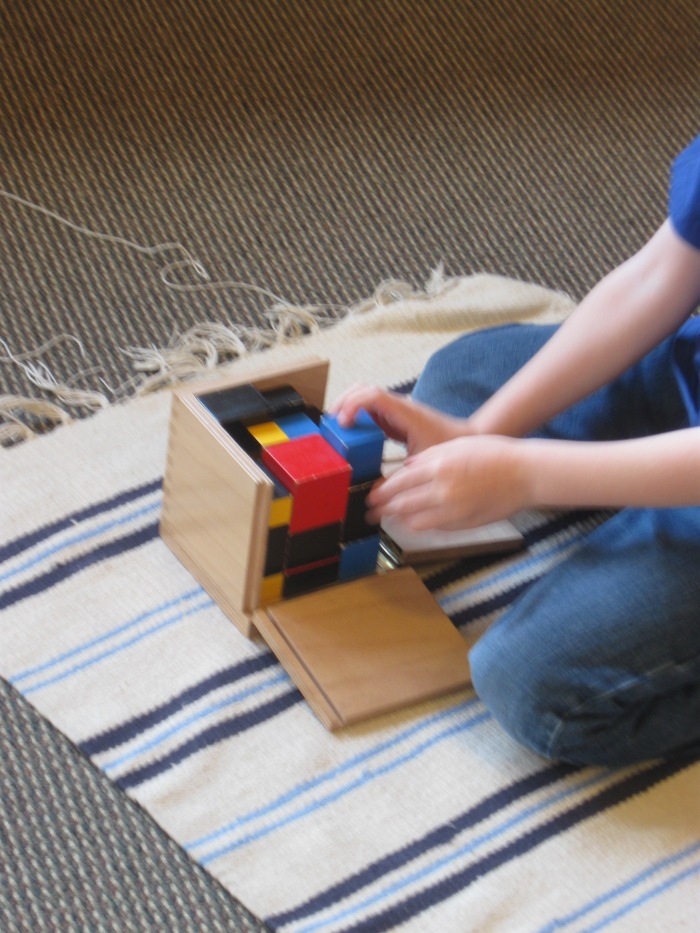Before I head into this subject, I would just like to thank everyone for their amazing support and compliments! I really didn’t expect this many people to read this or be that interested in what I write! I’m doing my best to write each piece as if I’m explaining this to someone who knows nothing about Montessori. If anything is ever unclear, please let me know!
—————————————————————————————————————————————
A Montessori environment is certainly a very unique one. If you ever have the chance to tour a Montessori “Children’s House” (as Maria Montessori called them) try to do so during a work period. What you will see is amazing – instead of sitting at desks, the children are at small tables, or on mats on the floor working with materials. One child may have out what appears to be just some plain blocks of varying sizes. Another child is slowly making their way around the room dusting the shelves. In one corner, a small group of children are gathered around a peer’s table admiring his finished book of flower parts. And even more impressive, there is not a teacher sitting with each child, hovering over them and correcting them. How on earth do they manage that? Clearly, if you’ve been around children, you know that everything they do is often filled with “oops”es – so how are these children actually learning anything if the teacher isn’t there directing them and explaining everything?
Maria Montessori designed her classrooms to be simple, true to life, and natural. In going through my training currently one of the many things I am learning about is how every single activity has multiple aspects that lead to the child being more independent. If the success of the child cannot be guaranteed, it is not an acceptable lesson. So not only did Maria design them to be beautiful, but each one has several lessons to be learned from it and they must be able to assist the child in learning successfully. Quite an intimidating thought, but if you break down the aspects of each work, you can see how the independence of the child thrives on the mechanics of each lesson. Every Montessori work has something called the Control of Error built into it. In my training, this is just one of the parts of each work we must learn, but today I saw some wonderful examples of Control of Error which is what brought it to my mind tonight when I sat down to write.
In a previous post I discussed the Pink Cubes, and their simple beauty. Building the cubes into a tower is just one way to do the work – there are very many variations that can be done. When the work is put away, just as the picture shows, it is put away in the tower formation. The Control of Error for building the Pink Cubes in the tower formation is a very simple one – if a child puts the wrong size cube towards the bottom or middle of the tower, it presents an obvious visual discrepancy. You wouldn’t think the children would mind it being a little wonky or off-kilter, but their amazing little minds thrive on order. I could go on and on with examples on how this has been proven in Child Development, instead I will say I frequently get children correcting works not put away correctly on the shelves. I do not ask them to, they do it because they desire that order. So when the child building the tower of Pink Cubes has the tower suddenly collapse on itself, they simply try again. It’s mesmerizing to watch a child put the cubes on top of each other slowly and carefully, then center each cube on the one below it before adding the next one. In the Practical Life section of the classroom, the Control of Error commonly found in a Montessori teacher’s Manual are things like “water is spilled on tray” or “not all beans are transferred from one bowl to the other”. Such seemingly simple concepts enable the child to be very independent in the classroom and successful in learning from their activities. With these Controls of Error, the teacher doesn’t need to watch over the child and say “Oh, perhaps you should try putting that block first so your tower doesn’t fall over.” It may seem difficult, and sometimes downright hard to not interfere with the child working, but as a Montessori teacher I am learning to trust the Control of Error, and leave the child to learn on their own.


This child did eventually correct his errors and was able to close the Trinomial box successfully.
If instead of this specifically designed box for the work, the children were just to put all of the pieces afterwards into a bag or basket, the work would be not only more cumbersome to retrieve off of the shelf, but the Control of Error wouldn’t have a chance to shine through. The child might attempt to put the cubes in the box in order and find they don’t fit. What is then the drive in the child to complete the work? They can just throw the pieces into the basket and go find a different work. Instead, this is how the work is stored so even a casual attempt at doing this activity leads to learning how to put the cubes in order.
Because of these well-designed works, the children become remarkably independent. It never ceases to amaze me how independent Montessori children are. Everyday I am surprised (somehow, you’d think I’d know better by now!) how adept they are at handling themselves. Instead of me filling their water-bottles when they are empty, the kids often say “I can do it!” They clean up completely after themselves, straighten up and maintain our classroom, and even at the age of three and four years assist with daily chores. This is a great lesson in independence in children – why shouldn’t we let them assist us in daily tasks? You have to ask yourself, what is the worst thing that can happen? Perhaps you have to clean up a small spill, or re-tidy a shelf when they aren’t looking – but the smile on their face when they proclaim “Look! I did it!” is worth so much more. They are capable of so much more than we give them credit for!
Hi! I just found your blog via Walk Beside Me. I think your posts are sooo interesting.
Hugs
I just came upon your blog. I love it! Thanks for this article. I’m always thinking of this.
Thank you Jessie, and welcome!